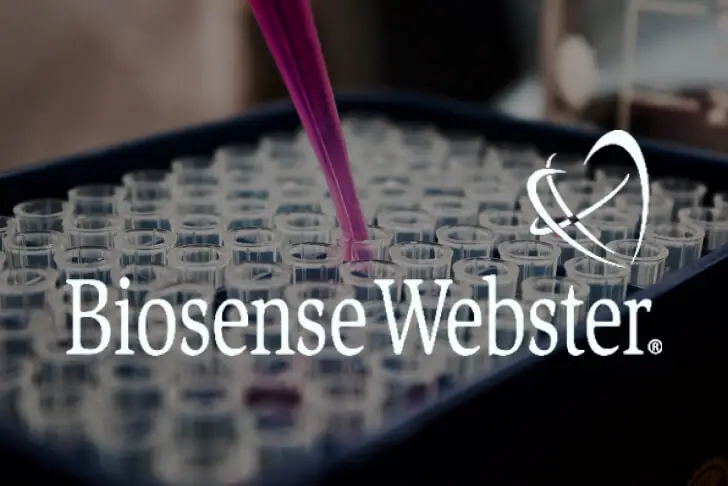Highlights:
- Reduced our inventory by 25%
- Lead time was reduced by 70%
- Reduction of space by 30%
Business Objectives:
The first useful deflectable tip catheter was pioneered by Will Webster more than three decades ago. Ever since then, the Webster name has been synonymous with industry-leading design and craftsmanship in diagnostic and therapeutic cardiac catheters. In 1993, revolutionary Biosense technology paved the way for important advancements in cardiac imaging. Combining these technology leaders as Biosense Webster, Inc. within the Johnson & Johnson family of companies has significantly enhanced both the science and the clinical application of electrophysiology.
Biosense Webster is positioned within the medical devices sector of Johnson & Johnson. The company has also become a world leader in software and hardware systems for three-dimensional cardiac mapping and navigation. Biosense Webster is recognized worldwide for its development of advanced cardiac catheter designs.
Headquartered in Diamond Bar, California Biosense performs 85 percent of its manufacturing in Juarez, Mexico. The Juarez, Mexico facility has become a prime producer of the Biosense Webster products. Operating for slightly over four years, today the plant assembles and ships packaged semi-finished products to the sterilizer facility in San Diego for final distribution domestically and the rest of the world.
The Business Challenges:
Marketing and customer demand have required a significant increase in the quantity of stock-keeping units, (SKUs), and features/options offered. This had put a strain on the existing facility’s ability to react appropriately to lead times and inventory investment decisions. Market demand from both customers and marketing has put strains on demand management and forecast accuracy levels that the plant must cope with.
Regulatory compliance, periodic audits, validations, and approvals from multiple governing agencies place a difficult demand in evaluating any dramatic changes to the operating environment. Regulatory documents typically arrive at the plant facility from California while the Device History Record (DHR) data is created and maintained at the plant.
In addition to the periodic audits from the regulatory agencies, Johnson & Johnson is ISO 9000 certified which brings an extra level of control that must be recorded, documented, and maintained during the transformation. This is a corporate mandate.
The FlowVision Solution:
Biosense Webster was not new to FlowVision. Based on the excellent work they performed at the corporate facilities in California, it was a logical choice to extend their capabilities to the Juarez facility. The Mexican facility presented a significant challenge on multiple fronts due to the plant location away from the corporate offices, product mix, demand signals, plant layout, and labor-intensive operations.
“It is the hands-on approach that FlowVison excels at. They educated us on what needed to be accomplished and they provided the tools and skills for our workforce to meet our goals,” said Manuel Garcia, Director of Manufacturing.
“More importantly, besides providing us with theory, they directly help with building the system and establishing the new production lines. They have exceptional knowledge transfer capabilities and we were tied to their sides during the implementation. Not only do they know the integrated lean environment and how it should operate, but they also translated that knowledge directly to our product sets and have made us self-sufficient.” Garcia added.
Implementation:
Before Flow was implemented the plant layout had to be re-designed. The existing environment led to high queue and lead times and increased buffer levels at each major work center. The plant was re-aligned into three views or lines so that each line could leverage basic technology and platform components depending on the type of catheters. A constraint that had to be addressed was the need to trace lots both forward and backward from a regulatory perspective.
The relocation of equipment was done over a long weekend. There was a slight build-up of inventory prior to the conversion as an insurance policy and extra care with respect to product and process quality during the conversion. The production of catheters is labor intensive. This impacted the implementation at two levels: the first on the design layout, and the second on educating lean principles. Since the plant was now aligned into similar production lines from cellular-based production, plant personnel were cross-trained on performing operations both upstream and downstream.
Lean audits, first done by FlowVision after implementation, are needed to review and balance the lines every 2-3 months. It is important for adapting the new parameters to reflect the changing product and demand fluctuations that occur. FlowVision transferred this knowledge and tools to the engineers and staff of Biosense Webster to make them self-sufficient.
Results:
After implementing Lean, multiple goals have been achieved. Inventory was reduced substantially even though the product mix continues to grow. “Improvements have been recognized everywhere,” said Garcia. “We have made tremendous gains in educating our operators, improving space utilization within our facilities, and most importantly the reduction in lead time which allows us to have a superior customer service level.”
In addition, the bottom line:
- Reduced our inventory by 25%
- Lead time was reduced by 70%
- Reduction of space by 30%
- Successful audits





